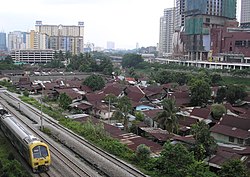This article needs additional citations for verification .(May 2024) |
KL Eco City | |
|---|---|
Mixed Development in Kuala Lumpur | |
 KL Eco City in July 2022 | |
| Nickname: KLEC | |
 Interactive map of KL Eco City | |
| Coordinates: 3°07′05″N101°40′23″E / 3.118°N 101.673°E | |
| Country | Malaysia |
| City | Kuala Lumpur |
| District | Bangsar |
| Status | Partially Completed |
| Developer | KL Eco City Sdn. Bhd. (a subsidiary of SP Setia) |
| Area | |
• Total | 10 ha (25 acres) |
| Time zone | UTC+8 (Malaysia Standard Time) |
| Postal code | 59200 |
| Website | www |

KL Eco City, or KLEC for short, is a 25-acre integrated mixed-use development project in the city of Kuala Lumpur, Malaysia. [1] The project is built at the site of former Haji Abdullah Hukum Village. The mixed development project is helmed by S P Setia Berhad under a joint-venture agreement with the Kuala Lumpur City Hall (DBKL). [2] It is built in stages comprising 3 residential towers, one serviced apartment tower, 3 corporate office towers, 12 boutique office blocks and a retail mall. [3]



